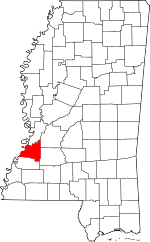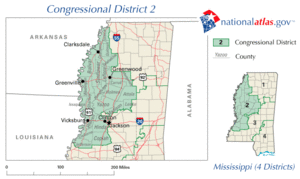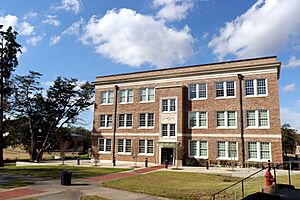Claiborne County, Mississippi facts for kids
Quick facts for kids
Claiborne County
|
|
|---|---|

Claiborne County courthouse and Confederate Monument in Port Gibson
|
|

Location within the U.S. state of Mississippi
|
|
 Mississippi's location within the U.S. |
|
| Country | |
| State | |
| Founded | 1802 |
| Named for | William C. C. Claiborne |
| Seat | Port Gibson |
| Largest city | Port Gibson |
| Area | |
| • Total | 501 sq mi (1,300 km2) |
| • Land | 487 sq mi (1,260 km2) |
| • Water | 14 sq mi (40 km2) 2.8% |
| Population
(2020)
|
|
| • Total | 9,135 |
| • Density | 18.234/sq mi (7.040/km2) |
| Time zone | UTC−6 (Central) |
| • Summer (DST) | UTC−5 (CDT) |
| Congressional district | 2nd |
Claiborne County is a county in the state of Mississippi. In 2020, about 9,135 people lived there. Its main town, called the county seat, is Port Gibson. The county is named after William C. C. Claiborne, who was the second governor of the Mississippi Territory.
Claiborne County is part of a larger area that includes Vicksburg and Jackson. The Mississippi River is to its west, and the Big Black River is to its north.
In 2020, this county had the highest number of Black or African American residents in any U.S. county, with 88.6% of the population. This area was once known for its large plantations where cotton was grown. Enslaved African Americans were forced to work on these plantations. After they became free, many generations of African Americans stayed in the area because of their family ties and their connection to the land.
Claiborne County was also a key place for important events during the civil rights movement.
Contents
History of Claiborne County
This area was first settled by French, Spanish, and English colonists, and later by American pioneers. It became the fourth county in the Mississippi Territory in 1802. Large cotton farms, called plantations, were developed here after the 1830s. At that time, many enslaved African Americans were brought to the area through the domestic slave trade. This trade moved about one million enslaved people from the Upper South to the Deep South, breaking apart many families.
The enslaved workers helped grow cotton on long farms that stretched along the Mississippi River and the Big Black River. These rivers were important for transportation. Even before the American Civil War, most of the people in the county were Black.
Life Before the Civil War
Grand Gulf was a busy port on the Mississippi River. Thousands of cotton bales were shipped from there every year before the Civil War. Cotton from Port Gibson and nearby counties came to Grand Gulf by railroad. However, the river changed its path, moving away from Grand Gulf. This caused the town to shrink from about 1,000-1,500 people in 1858 to only 150 by the end of the century, becoming a ghost town.
In Port Gibson, businesses included a cotton gin and a cottonseed oil mill, which continued to operate into the 20th century. Port Gibson was also a center for trade in the area.
After the Civil War
After the Reconstruction era, white politicians regained power in Mississippi. Groups like the Red Shirts used violence and unfair methods to stop Black people from voting. These groups were like the "military arm" of the Democratic Party.
In the late 1800s, political districts were redrawn to reduce the power of Black voters. A long, narrow congressional district was created along the Mississippi River, where most Black people lived. This way of drawing districts, called gerrymandering, helped white politicians keep power. Today, Claiborne County is part of the 2nd congressional district, which has a Black majority, as you can see on the map.
In 1890, a new state constitution was passed. It included rules like poll taxes and literacy tests. These rules were used to stop most Black people and many poor white people from voting. This unfair system continued until the civil rights movement led to new federal laws in the 1960s, like the Civil Rights Act of 1964 and the Voting Rights Act of 1965.
The county's economy still relied on farming. After slavery ended, a system called sharecropping became common. More than 80% of African American workers were sharecroppers from the late 1800s to the 1930s.
20th Century and Civil Rights
Because they faced unfair treatment and danger, many Black people left Claiborne County and Mississippi during the Great Migration. They moved to cities in the North and Midwest, like Chicago, to find jobs and better opportunities. Between 1900 and 1920, the county's population dropped by 41%.
Even after national civil rights laws were passed in the 1960s, African Americans in Claiborne County still faced challenges. They wanted to be treated with respect and be fully included in public life. White residents often held onto old ideas of Black inferiority.
In 1966, Black residents formed a group called the Deacons for Defense. They carried weapons for self-defense and followed the law. They even worked with the county sheriff to keep peace. Later, some of the Deacons became law enforcement officers, and two were the first Black people to run for county sheriff.
In the late 1960s, African Americans worked hard to integrate schools and to register to vote. NAACP leader Charles Evers helped many people register to vote and join the NAACP in Claiborne and nearby counties.
To gain equal opportunities in local businesses, African Americans started an economic boycott of stores in Port Gibson. Charles Evers led this boycott. The boycott was later supported by the United States Supreme Court as a legal way to protest.
The boycott ended in early 1967 when businesses agreed to hire Black clerks. Almost two dozen people were hired, and stores promised better treatment for Black shoppers. Also, 50 Black students started attending schools that used to be only for white students. In 1979, Frank Davis became the county's first Black sheriff since the Reconstruction.
Since 2003, Claiborne County has been part of the Black-majority 2nd congressional district. Voters here usually support Democratic candidates.
Law Enforcement
The Claiborne County Sheriff's Department started in 1818. A. Barnes was the first sheriff. Even though most people in Claiborne County are Black, there have only been three Black sheriffs. In 1874, during the Reconstruction Era, Thomas Bland became the first Black sheriff, serving for less than a year.
It was over a hundred years later, in 1979, when Frank Davis became the next Black sheriff. He served until 2012. Marvin Lucas then took office, and Frank Davis became sheriff again in January 2016.
Geography
Claiborne County covers about 501 square miles. Most of this is land (487 square miles), and 14 square miles (2.8%) is water.
Main Roads
 U.S. Route 61
U.S. Route 61 Mississippi Highway 18
Mississippi Highway 18 Mississippi Highway 547
Mississippi Highway 547 Mississippi Highway 548
Mississippi Highway 548- Natchez Trace Parkway
Nearby Counties
- Warren County (north)
- Hinds County (northeast)
- Copiah County (southeast)
- Jefferson County (south)
- Tensas Parish, Louisiana (west)
Protected Areas
- Natchez Trace Parkway (part of it)
Population Information
| Historical population | |||
|---|---|---|---|
| Census | Pop. | %± | |
| 1810 | 3,102 | — | |
| 1820 | 5,963 | 92.2% | |
| 1830 | 9,787 | 64.1% | |
| 1840 | 13,078 | 33.6% | |
| 1850 | 14,941 | 14.2% | |
| 1860 | 15,679 | 4.9% | |
| 1870 | 13,386 | −14.6% | |
| 1880 | 16,768 | 25.3% | |
| 1890 | 14,516 | −13.4% | |
| 1900 | 20,787 | 43.2% | |
| 1910 | 17,403 | −16.3% | |
| 1920 | 13,019 | −25.2% | |
| 1930 | 12,152 | −6.7% | |
| 1940 | 12,810 | 5.4% | |
| 1950 | 11,944 | −6.8% | |
| 1960 | 10,845 | −9.2% | |
| 1970 | 10,086 | −7.0% | |
| 1980 | 12,279 | 21.7% | |
| 1990 | 11,370 | −7.4% | |
| 2000 | 11,831 | 4.1% | |
| 2010 | 9,604 | −18.8% | |
| 2020 | 9,135 | −4.9% | |
| 2023 (est.) | 8,617 | −10.3% | |
| U.S. Decennial Census 1790-1960 1900-1990 1990-2000 2010-2013 |
|||
The population of Claiborne County has changed over time. From 1940 to 1979, the number of people went down as more African Americans moved away during the Great Migration. After a small increase from 1970 to 1980, the population has decreased by almost 25% since 1980. This is because there are not many job opportunities in the county, so people have moved elsewhere.
| Race | Num. | Perc. |
|---|---|---|
| White | 974 | 10.66% |
| Black or African American | 7,959 | 87.13% |
| Native American | 8 | 0.09% |
| Other/Mixed | 122 | 1.34% |
| Hispanic or Latino | 72 | 0.79% |
In 2020, there were 9,135 people living in the county. This included 2,908 households and 1,897 families.
Communities
City
- Port Gibson (This is the county seat and the only city.)
Census-Designated Places
Unincorporated Communities
Ghost Towns
Places to Visit
- Alcorn State University
- Claiborne County Courthouse
- Grand Gulf Nuclear Generating Station
- Grand Gulf Military State Park (Mississippi)
- Windsor Ruins
Education
All schools in the county are part of the Claiborne County School District.
The county is also served by Hinds Community College.
Notable People
- E. S. Dortch: A planter and politician born in Claiborne County in 1841.
- Abijah Hunt: A merchant who became a major planter in the area.
- David Hunt: Abijah Hunt's nephew, who inherited and expanded the family's plantations, becoming very wealthy.
- James Monroe Trotter: The first African American to be promoted to lieutenant in the U.S. Army during the Civil War.
- Joseph Edison Walker: A doctor and business owner born in Tillman. He founded Universal Life Insurance Company, a large Black-owned insurance company.
- Irwin Russell: A poet.
- Henry Hughes: A sociologist.
- Thomas C. Healy: A painter.
- Joshua C. Clark: A politician.
- Henry T. Ellett: A lawyer and politician.
- Olivia Hastings: An advocate for women's education.
- May Russell: An organizer for the Women's Christian Temperance Union (WCTU).
See also
 In Spanish: Condado de Claiborne (Misisipi) para niños
In Spanish: Condado de Claiborne (Misisipi) para niños



